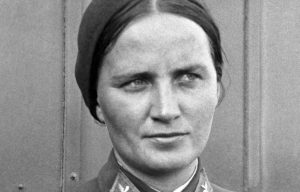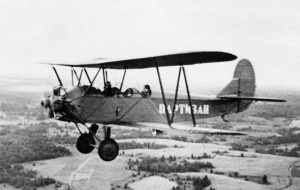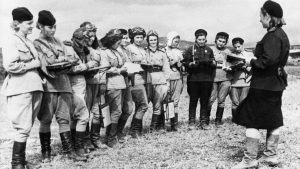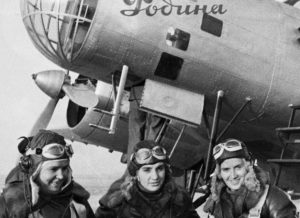
 During and before World War II, and even after to a large degree, women were not allowed to hold combat positions, but the Soviets found that the enemy was fast encroaching on them, and there was no other choice. Using female bombardiers was even more undesirable, but Adolf Hitler had launched Operation Barbarossa, which was his massive invasion of the Soviet Union, in June 1941. By that autumn, the Germans were pressing on Moscow, Leningrad was under siege and the Red Army was struggling. The Soviets were desperate.
During and before World War II, and even after to a large degree, women were not allowed to hold combat positions, but the Soviets found that the enemy was fast encroaching on them, and there was no other choice. Using female bombardiers was even more undesirable, but Adolf Hitler had launched Operation Barbarossa, which was his massive invasion of the Soviet Union, in June 1941. By that autumn, the Germans were pressing on Moscow, Leningrad was under siege and the Red Army was struggling. The Soviets were desperate.
Marina Raskova, who was also known as the “Soviet Amelia Earhart,” had brainstormed the idea of a female squadron. She was famous not only as the first female navigator in the Soviet Air Force but also for her many long-distance flight records. Marina had been receiving letters from women all across the Soviet Union wanting to join the World War II war effort. Oh sure, they could go in as nurses, secretaries, or in some other support roles, but these women already knew how to fly. They had been training in air clubs all over the Soviet Union. They wanted to be gunners and pilots, flying on their own. Many of these women had lost brothers or boyfriends, and many had seen their homes and villages destroyed. Raskova petitioned Soviet dictator Joseph Stalin to let her form an all-female fighting squadron. Stalin wasn’t too keen on the idea, but it soon became apparent that they had no other choice.
On October 8, 1941, Stalin agreed to the plan and gave orders to deploy three all-female air force units. These women were going to be full-combat soldiers. They would not only fly missions and drop bombs, they would return fire too. With this action, the Soviet Union became the first nation to officially allow women to engage in combat. Previously, even women pilots could only help transfer planes and ammunition. Then, the men took over. Raskova quickly started to fill out her teams. She had more than 2,000 applications to choose from. She selected about 400 women for each of the three units. These were not long time pilots, but rather, most were students, ranging in age from 17 to 26. Those selected moved to Engels, a small town north of Stalingrad, to begin training at the Engels School of Aviation. The women underwent a highly compressed education, and were expected to learn in a few months what it took most soldiers several years to grasp. The only thing in their favor was that they already knew how to fly, just not in combat. Each recruit had to train and perform as pilots, navigators, maintenance and ground crew. Then the positions were assigned. The women faced skepticism from most of the male military personnel who believed they added no value to the combat effort, and called them “princesses.” Raskova did her best to prepare her women for these attitudes, but they still faced sexual harassment, long nights, and grueling conditions. “The men didn’t like the ‘little girls’ going to the front line. It was a man’s thing.” Assigned Polikarpov Po-2 biplanes, which was a bare-bones plywood biplane, the women flew under the cover of night. These light two-seater, open-cockpit planes were never meant for combat, and were often referred to as “a coffin with wings.” Made out of plywood with canvas pulled over, the aircraft offered virtually no protection from the elements. Flying at night, pilots endured freezing temperatures, wind, and frostbite. In the harsh Soviet winters, the planes became so cold, touching them caused skin to stick and rip off. They were given uniforms handed down from the men, and boots that were too big, and had to have the toes stuffed, so they would not slip.
In the air, they braved bullets and frostbite, while on the ground, they battled skepticism and sexual harassment. Nevertheless, in the air, they were so feared and hated by the Nazis that any German airman who downed one of these planes was automatically awarded the prestigious Iron Cross medal. All told, the unique all-female 588th Night Bomber Regiment dropped more than 23,000 tons of bombs on Nazi targets. And in doing so, they became a crucial Soviet asset in winning World War II. The Germans nicknamed them the Nachthexen, or “night witches,” because the whooshing noise their wooden planes made resembled that of a sweeping broom. “This sound was the only warning the Germans had. The planes were too small to show up on radar, or on infrared locators,” said Steve Prowse, author of the screenplay The Night Witches, a nonfiction account of the little-known female squadron. “They never used radios, so radio locators couldn’t pick them up either. They were basically ghosts.”
Due to both the planes’ limited weight capacity and the military’s limited funds, the female pilots didn’t have some of the basic necessities. Parachutes were deemed a “luxury” item. The added weight was just too much. They also didn’t have radar, guns, and radios. They were forced to use more rudimentary tools such as rulers, stopwatches, flashlights, pencils, maps, and compasses. Because these planes flew slower than the stall speed of the Nazi planes, they were very good at maneuvering out of the way of the German planes, making them hard to target. They also could easily take off and land from most locations. Still, there was a downside too. Whenever they did come under enemy fire, the pilots had to duck by sending their planes into dives, because most of them carried no defense ammunition. If they were hit by tracer bullets, which carry a pyrotechnic charge, the wooden planes would burst into flames, killing the crew.
One of the biggest drawbacks was that the Polikarpovs could only carry two bombs at a time…one under each wing. Two bombs per plane was not going to make much of a dent in the German targets, so the regiment sent out up to 40 two-person crews a night. Each would fly between 8 and 18 missions a night, returning to base to re-arm between runs. The weight of the bombs forced them to fly at lower altitudes, making them a much easier target, which is why they only flew missions at night. Each mission found the planes traveling in packs. The first planes were used as bait. Their job was to attract German spotlights, which provided the pack with much needed illumination. These bait-planes, rarely had ammunition to defend themselves. They would release a flare to light up the intended target. The last plane would idle its engines and glide in darkness to the bombing area. It was this “stealth mode” that created their signature witch’s broom sound. While these women were a formidable foe, they were also women. The Night Witches followed 12 commandments, the first of which was “be proud you are a woman.” They might be fierce killers of the Germans, but in their downtime they were still women. They did needlework, patchwork, decorated their planes and danced. They even put the pencils they used for navigation into double duty as eyeliner.
The last flight of the Night Witches took place on May 4, 1945…when they flew within 37 miles of Berlin. Three days later, Germany officially surrendered. According to Prowse, “the Germans had two theories about why these women were so successful: They were all criminals who were masters at stealing and had been sent to the front line as punishment, or they had been given special injections that allowed them to see in the night,” both of these “theories” make me laugh, like the female pilots couldn’t be just that…excellent fighter pilots in their own right. Altogether these capable, albeit “crazy” heroines flew more than 30,000 missions, or about 800 per pilot and navigator. They lost a total of 30 pilots, and 24 of the flyers were awarded the title Hero of the Soviet Union. Marina Raskova, who had spearheaded the movement, died on January 4, 1943, when her plane was shot down on a mission very near the front line. Hers was the very first state funeral of World War II and 
 her ashes were buried in the Kremlin. The all-female 588th Night Bomber Regiment, despite being the most highly decorated unit in the Soviet Air Force during the World War II, was disbanded six months after the end of the war. When the big victory-day parade in Moscow was held, they weren’t included, because it was decided that their planes were too slow. Amazing!!!
her ashes were buried in the Kremlin. The all-female 588th Night Bomber Regiment, despite being the most highly decorated unit in the Soviet Air Force during the World War II, was disbanded six months after the end of the war. When the big victory-day parade in Moscow was held, they weren’t included, because it was decided that their planes were too slow. Amazing!!!


One Response to Nachthexen